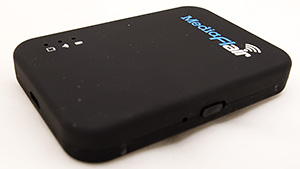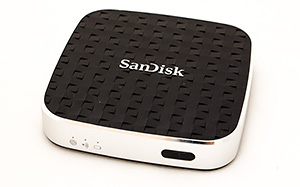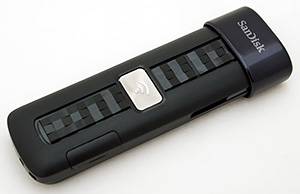Photo Corners headlinesarchivemikepasini.com
![]()
A S C R A P B O O K O F S O L U T I O N S F O R T H E P H O T O G R A P H E R
![]()
Enhancing the enjoyment of taking pictures with news that matters, features that entertain and images that delight. Published frequently.
Three Wireless Storage Solutions




8 January 2014
On the hardest decisions you have to make when buying an iOS or Android mobile device is deciding how much internal storage to buy. It doesn't help that the devices are themselves not cheap and it really doesn't help that, on top of that, internal storage is priced at a premium.
But we've always managed to go small -- with a little help from external storage of one kind or another. And when you think of it, that's a time-honored tradition in computing.
A LITTLE HISTORY | Back to Contents
The history of data storage can be amusing (especially the way we remember it). First was the desire to record things like keystrokes. Paper tape and then magnetic tape answered that call. But it didn't take long to realize random access to the stored material was a lot preferable than sequential access. The disk (in 8-inch and then 4.25-inch and then smaller sizes) came to the rescue.

Escort MediaFlair. SD card storage.
When capacity was the issue and two sides of a disk didn't cut it, the hard disk in ever-growing capacities became standard equipment. Today it is slowly being phased out in favor of faster solid state circuitry.
But there's a parallel development in local storage that suggests a different path.
When iPods were all the rage, Apple enticed buyers with more and more capacity, promising to hold an entire music library in the palm of your hand using small hard drives. A few years later, it tried a different approach with the iPod Shuffle, suggesting you might only need a selection of songs, perhaps even just a random selection, on your device.
But you never really do know what you need until you need it. Enter cloud storage, which gives you access to your library's titles on a remote server without requiring storage space on your mobile device.
THE WIRELESS SOLUTION | Back to Contents
Between these two approaches there's a third that's a bit of both.
WiFi radios are everywhere. They're in your multifunction device so you can print or scan wirelessly. They're in your smartphone and tablet to save your network charges. They're even in your SD cards to make it easy to transfer images from a camera.

SanDisk Media Drive. Internal plus SD card storage.
So why not take a WiFi radio and mate it with solid state storage?
That would give you a portable storage device you can access wirelessly with the security of internal storage but the expandability of external storage.
While there are hard disk options available, this review looks at three lower-cost options that use memory cards or build-in solid state circuitry for the storage part of the solution.
The advantage of memory cards is simply that you can swap them, so the device can have access to an unlimited amount of data. But solid state solutions provide significantly more data storage in one gulp. And, happily, you don't have to choose. You can get solid state with a card, too.
On the other end of the seesaw, the wireless and other capabilities are best thought of as a router rather than a computer. There's no operating system in these things so file copying is not guaranteed to be available on the device itself, although the SanDisk Media Drive's latest firmware now supports this. But you can share the device's contents with a number of users. You can leave the device open or assign a password for access, just as you would a router.
SOME LIMITS | Back to Contents
The wireless connection is where things get interesting for all these devices. First, your mobile device only connects to one router at a time. So you'll have to connect to the device.

SanDisk Flash Drive. Micro SD card storage.
And that device will be a Wireless B device, running at a pretty slow speed compared to the Wireless G/N/AC devices.
You might think that's no big deal. After all, you're just connecting the storage device to your mobile device. But actually, the storage devices all offer bridge mode that let's you connect again through an app (included with purchase but downloaded separately) to your router and the outside world.
Unfortunately, it does that at B speed. If you don't have a dual-band router than can run all the B guys on one channel and all the faster guys on another, it will slow your whole network down.
On the plus side, though, these devices allow you to share any WiFi access. So rather than pay a per-device hotel charge for WiFi access, for example, you can connect just the storage device to the hotel's router and share _that_ single connection among devices.
THE APP SOLUTION | Back to Contents
The app we mentioned does more than provide a bridge to your router. It substitutes for the missing operating system by providing file transfers from your mobile device to the storage device. Once transferred, a file can be shared.
But the app runs on your mobile device and controls the mobile device's transfers. It can't effect a transfer from a card in the storage device to any internal storage on the storage device. So no, you can't copy your camera images from its SD card to the storage device.
In the course of our testing, all of the apps for these devices (and each uses its own) were updated more than once.
FROM THE COMPUTER | Back to Contents
And just as importantly, don't expect to access the storage device wirelessly from your computer because there's no app running on your computer, just your mobile device. So no http or ftp access, although the SanDisk devices to provide this with the current firmware.
You can access the storage device as a router, of course, and in bridge mode access the Internet. But you can't necessarily see what's stored on it.
Access to the storage device from you computer is available through a wired USB connection. So just like an SD card reader or a thumbdrive, you can plug it in to access it.
But that's also one way to charge the internal battery. You can also plug it into a USB charger that draws power from your household outlets or auto battery.
When you are connected via USB, however, the WiFi capability may not active, although the MediaFlair does support WiFi while charing the unit through a USB connection.
ONWARD | Back to Contents
Those are the rules. Still want to play?
Then join us as we look at the Escort MediaFlair, the SanDisk Media Drive and the SanDisk Flash Drive in this review. And don't miss our final thoughts and one big confession at the end of it.
(Editor's Note: This is the first of a five-part series on wireless storage. Links to the other stories are in the main table of contents at the top right of each story.)